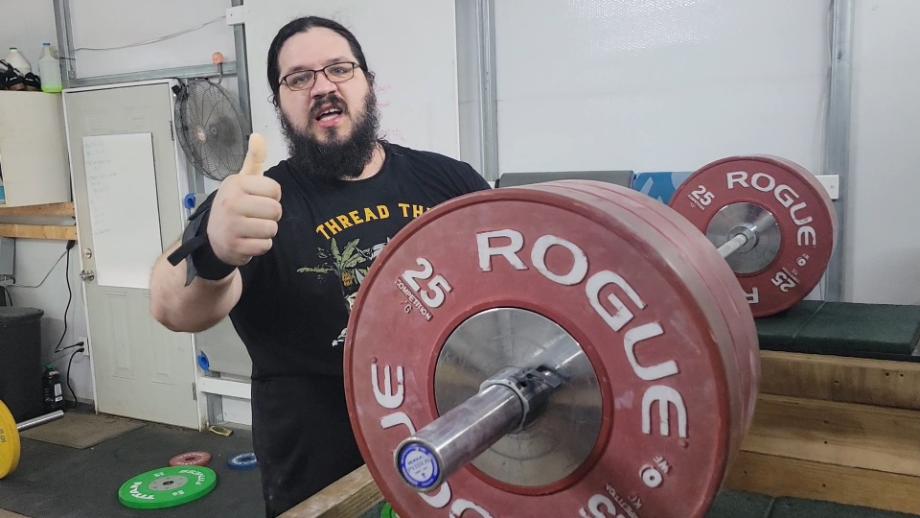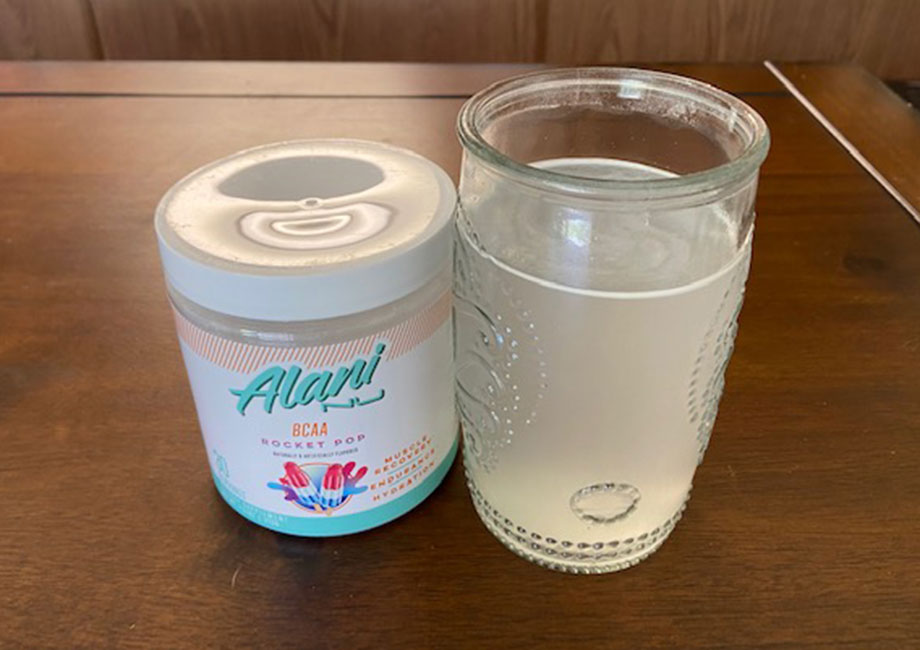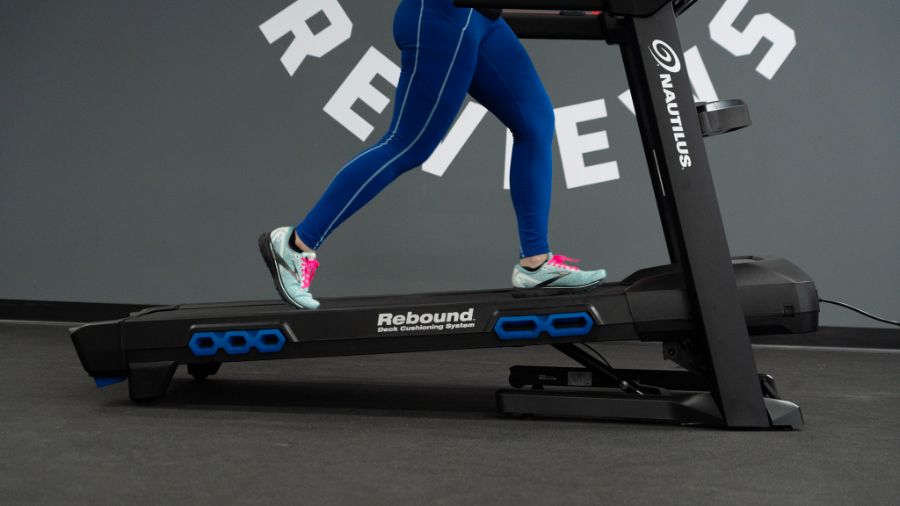As an Olympian in the sport of weightlifting, I know that you want the best Olympic barbell, plates, and collars on the lifting platform come competition day. The International Weightlifting Federation (IWF) knows this, too, which is why they have strict regulations on the specifications of the barbell and bumper plates used—so strict, that they’ve only approved six brands for international competition.
RELATED: An Olympian’s Guide to Equipment for Olympic Weightlifting
The latest brand to be certified for international competition is no stranger to the world of strength sports: Rogue Fitness. With their competition-approved bumper plates, they’ve created durable weight plates that can endure the thousands of reps performed over the span of a two-week meet.
But with that increased quality comes an increased price. In this Rogue Competition Bumpers review, I’ll go over my experience with these bumpers as an athlete and share the experiences of a couple of gym owners. We’ll see what kind of garage gyms these bumper plates are best suited for, and if they’re worth their hefty price tag.
Hundreds of Bumpers Dropped, Bounced, and Tested
I’ve been involved in the sport of weightlifting for 25 years. In that time, I’ve come across hundreds of the best bumper plates, lifting with them, dropping them, bouncing them, and everything in between. I put them through thousands of reps in snatches, clean and jerks, and squats.
I’m not an anomaly, either. GGR’s team of certified personal trainers, lifting and strength coaches, and competitive athletes has used and tested weight plates and other fitness equipment to provide expert and honest opinions on home gym essentials.
For this review, we asked Endless Strength Barbell Club owner Jacob Penner, USAW-L2, to test the Rogue Competition Bumper Plates. Additionally, I’ll draw from my experience with these plates both in competition and in training.
When testing these plates, Jacob took a look at the following aspects, rating each feature from 1 to 5:
- Durability and construction
- Weight tolerance
- Bounce
- Design and ergonomics
- Weight options
- Overall value
Rogue Competition Bumpers
Rogue KG Competition Bumper Plates
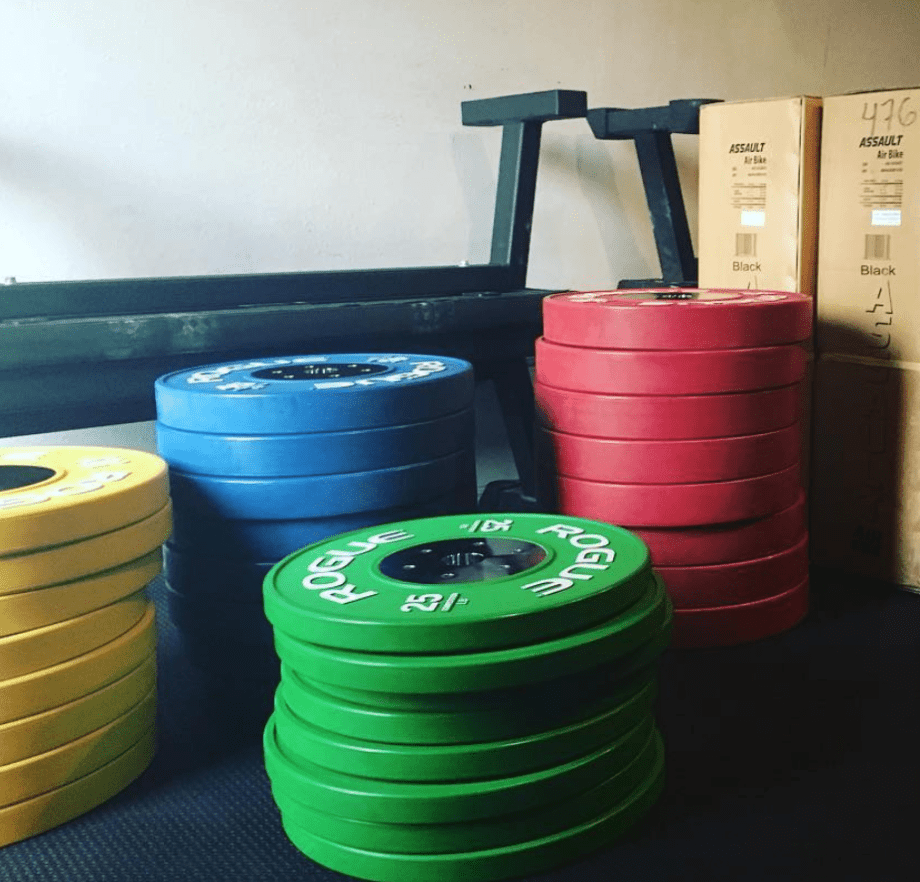
Product Highlights
-
5-year warranty
-
Weight tolerance of +/- 15 grams
-
Available in KG sizes
Pros & Cons
Pros
- Weight tolerance of +/- 15 grams
- Chrome-plated steel hub
- Durable with low bounce
- Meets IWF standards
Cons
- No free shipping
- More expensive than regular bumpers
Bottom Line
Rogue’s KG competition plates are built for elite performance with a dead bounce and precise weight tolerances. If you’re a competitive weightlifter or simply want clean, durable bumper plates, and you have the money, these are a great option.
A Quick Look at the Rogue Competition Bumpers
Rogue Fitness began in owner Bill Henniger’s garage in 2006, and has since successfully grown into a powerhouse in strength and fitness equipment. A staple in CrossFit and strength sports, Rogue became the official sponsor of USA Weightlifting in 2017. They then pursued certification through the IWF so their products could be used in international competition.
RELATED: USA Weightlifting Certification Review
The company achieved its official status as a sponsor of the IWF in 2019. The first international competition that used Rogue plates and barbells was the 2019 Las Vegas International Open—which I competed in.

To be eligible for international competition, the International Weightlifting Federation requires bars and plates to have tight weight tolerances and specific dimensions. This ensures that athletes use the same level of quality equipment for each meet, whether it’s a Pan American championship or the Olympic Games.
In particular, the IWF-certified Rogue Competition Bumpers are made in 10-, 15-, 20- and 25-kilogram plates and have a tight weight tolerance—within 15 grams of the declared bumper plate’s weight. In addition, the bumper plates have a diameter of 450 millimeters (17.7 inches), and a collar opening of 50.4 millimeters (about 2 inches), all in accordance with IWF standards.
Before You Buy
- If you’re not used to loading your bar in kilograms, Rogue does offer competition bumpers in pounds. Although they have the same tight tolerances as the kilogram competition bumpers, the pound plates aren’t certified by the IWF.
- You can purchase the Rogue Competition Bumpers as individual pairs, or as a set—of which there are four different weight set options. Keep in mind that the weight set prices already include shipping costs; if you buy individual pairs, shipping costs are calculated at checkout.
- If the competition bumpers are too pricey, but you’re still looking for IWF quality, you can also look at the Rogue Training Plates, which are also certified by the IWF for training hall use at competitions. These plates are still pricey, though not as much as the competition bumpers.
Are the Rogue Competition Bumpers Worth It?
We’ll get into the specifics later, but being a competition-certified bumper plate, the Rogue Competition Bumpers are very nice. With a strong virgin rubber and steel disc insert, these are durable and will last. The IWF standards require tight tolerances and quality, so you’ll rarely find a weight plate that’s ridiculously off in its mass or build.
That said, with the top-tier quality comes a top-tier price. The 140-kilogram competition set of bumper plates (which includes four pairs of plates) comes out to $1,155. That is about $8.25 per kilogram, or nearly $4 per pound. That’s pretty pricey compared to other bumper plates.
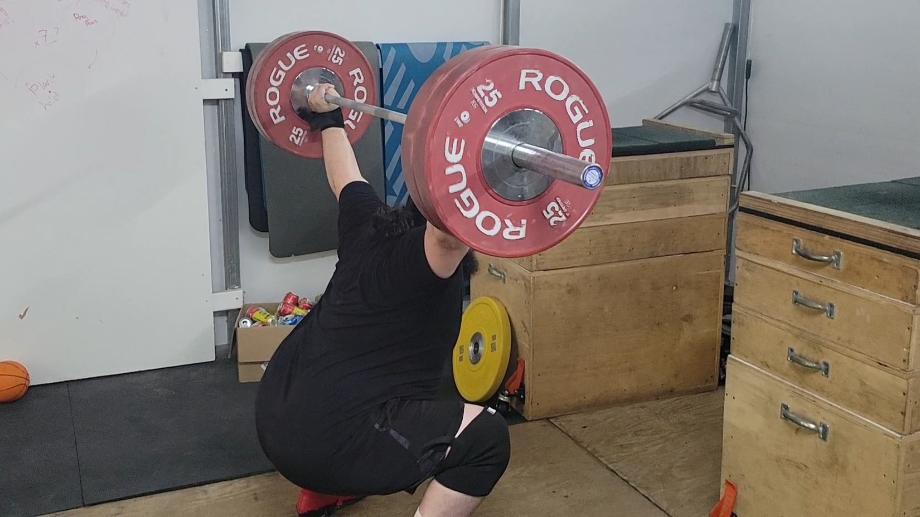
On the lowest end (think CAP Barbell), rubber black bumper plates can cost just over $1 per pound. A more durable rubber plate that we often recommend—the Rogue Echo Bumper Plates—costs $2.13 per pound and has great durability, a dead bounce, and a 1% weight tolerance. Even similar color-coded kilogram bumpers like those from Titan Fitness are cheaper, costing $3.20 per pound.
The competition bumper plates by Rogue are fantastic weight plates, but at their price point, they won’t make sense for most home gym owners. There are plenty of cheaper options that will perform just as well. The Rogue Competition Bumpers get a 3.5 out of 5 for the value, because the well-constructed plates just won’t fit into most people’s budgets.
Still, these plates are great to get if you want to splurge, or if you’re looking to compete in weightlifting—particularly on a national or international level.
Great for:
- Dedicated competitive Olympic weightlifters
- A home gym owner looking for a premium set of bumpers
- Coaches who plan on hosting Olympic weightlifting competitions
Not recommended for:
- People looking for the best value in their gym equipment
- Lifters who prefer to lift in pounds, not kilograms
- Powerlifters who prefer iron plates
Rogue Competition Bumper Plate Specs
| Material | Rubber |
| Weight range | 10-, 15-, 20-, and 25-kg plates |
| Weight tolerance | +/- 15 g of declared weight |
| Diameter | 450 mm |
| Insert | Chrome-plated steel disc with 50.4-mm collar opening |
| 10 kg plate width | 1.15” |
| 15 kg plate width | 1.65” |
| 20 kg plate width | 2.15” |
| 25 kg plate width | 2.5” |
| Durometer rating | 94 |
| Warranty | 5 years |
Using the Rogue Competition Bumpers
Jacob Penner, USAW-L2, owner of Endless Strength Barbell and part of GGR’s expert panel, has owned Rogue Competition Bumpers for a few years now. They get regular use in his gym, from himself and other athletes.
“I’ve used Rogue bumper plates for six years,” Jacob adds, “and I think I’ve used them in just about every single training session I’ve done in my gym.”
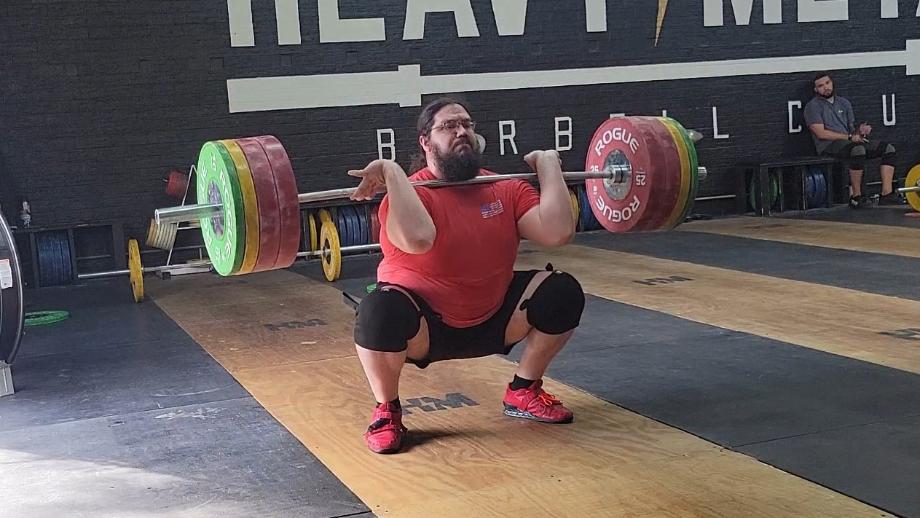
I myself have used Rogue competition bumpers in a variety of gyms, training camps, and competitions over the last decade. Both Jacob and I train in Olympic lifting, meaning we’ve clocked in thousands of reps with these bumper plates doing snatch exercises, clean and jerks, squats, deadlifts, and pulls.
Construction and Durability
Rogue Competition Bumper Plates are one of the few Rogue items that aren’t made in the United States. While Rogue doesn’t specify where the rubber is imported from, a lot of rubber for bumpers and dumbbells is imported from China.
Each bumper plate is built to IWF-compliant specifications, notably a 450-millimeter diameter and a collar opening that is 50.4 millimeters—allowing for a tight fit on an Olympic barbell.
To maintain a durable center hub, Rogue uses large chrome-plated steel discs. Over time, the area where the disc meets rubber is usually the breaking point of a bumper plate. However the larger steel disc will hold up far better than a smaller stainless steel insert in less expensive hi-temp plates.
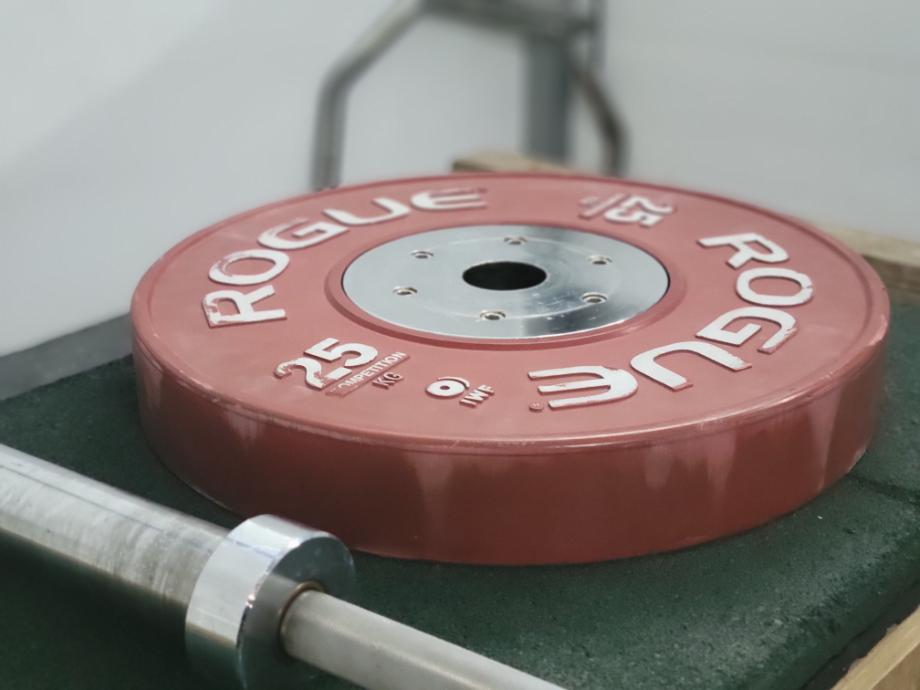
The dense rubber remains durable, even after years of use. Jacob’s 25-kilogram bumper plates are 5 years old at this point. Even with constant use, the weight plates have held up remarkably well. There are some minor signs of wear—for example, some paint fading on the lettering and some scuff marks—but the bumper plates are largely intact and hold up just as well as day one. Jacob rates the construction and durability a strong 4.75 out of 5.
Weight Tolerance
To stick with IWF specifications, Rogue bumpers maintain a strict weight tolerance. They are no more than 15 grams lighter or heavier than the declared weight of the bumper plate. Jacob rates the weight tolerance a 5 out of 5, as Rogue keeps to their strict specs. He recalls, “I actually weighed a 25-kilogram plate for an online qualifier one of my athletes had to do, and it was exactly 25 kilograms.”
Bounce
The bumper plates perform well with a dead bounce. Most plates I’ve lifted with in competitions have a low, dead bounce, but Rogue Competition Bumpers take the cake. They barely bounce up from platforms after a 210-kilogram (or more) clean and jerk. These are a bit wider than some other IWF competition plates (like Eleiko or ZKC plates), which might help provide less bounce, but it’ll also make the plates a little louder upon impact.
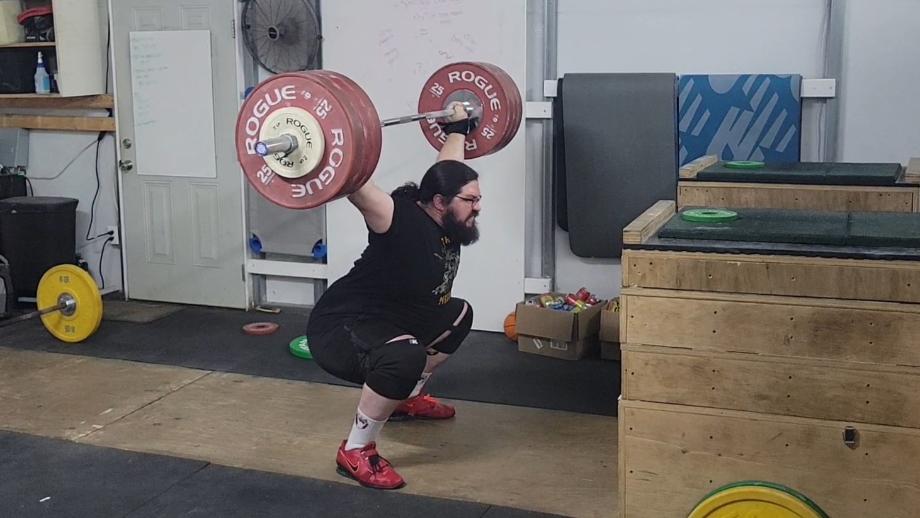
Another reason the Rogue Competition Bumpers have a low bounce is the Durometer rating. The Durometer is a rating of the amount of bounce from the plate and rubber. A higher rating means a lower bounce, which will better protect your home gym flooring and equipment. Rogue’s competition bumpers have a Durometer rating of 94, which is one of the highest ratings I’ve personally seen, earning it a 5 out of 5 for bounce.
Design and Ergonomics
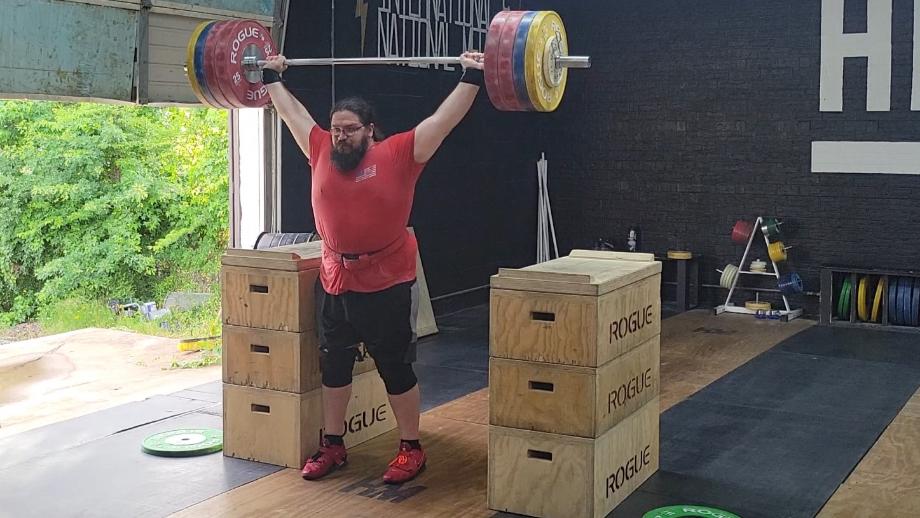
Per IWF standards, the bumper plates are color-coded for easy reference to tell what weight is on the barbell:
- 10-kg plates are green.
- 15-kg plates are yellow.
- 20-kg plates are blue.
- 25-kg plates are red.
Anyone who’s a regular in the sport can glance at your bar and roughly know the weight on it within seconds. Plus, the colors help make the weights look sharp. Jacob adds, “These keep their color really well. USA Weightlifting uses Rogue competition plates every year, and they’ve been used multiple times. The color is still really vibrant.”
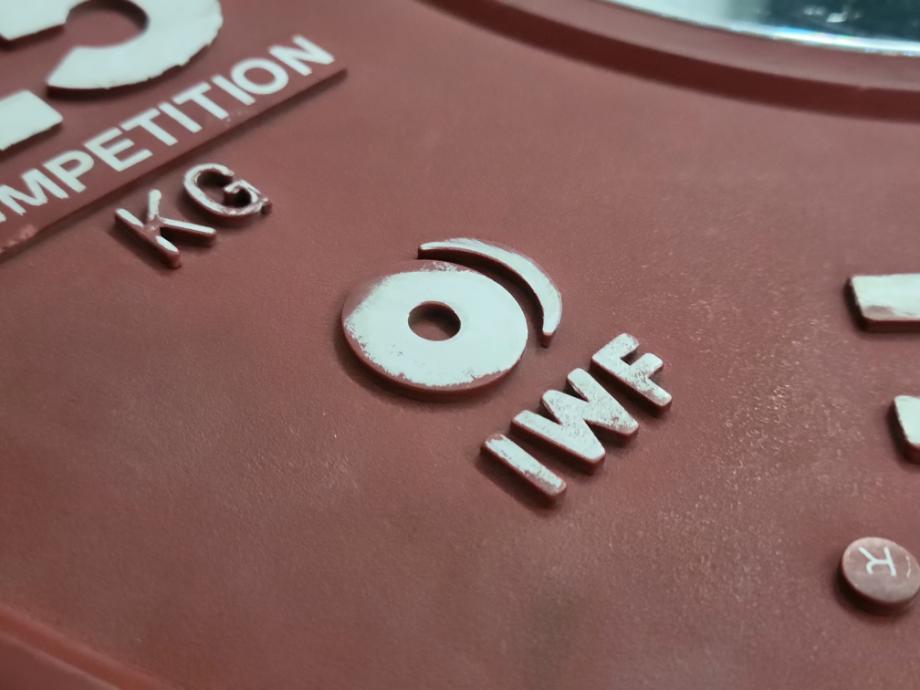
The design of the plates is very sharp, with the lettering raised on the plate and then painted white, to stand out to the color-coded bumper plate. Because these kilogram plates are IWF-certified, a small IWF logo is on either side of the rubber bumper plate as well.
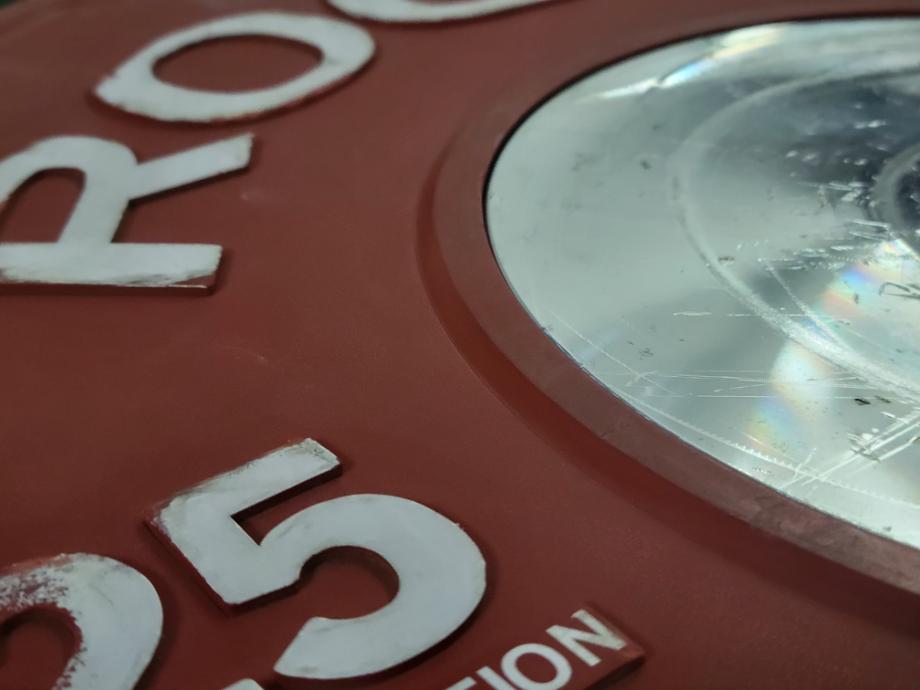
A unique design feature that Rogue incorporates is a raised rubber flange along the edge of the steel disc insert, which prevents the bumper plate’s metal from making direct metal-on-metal contact with another bumper plate. For little design choices like this, we also have to give the plate’s design a 5 out of 5.
Rogue Competition Bumper Plates vs REP Fitness Competition Bumper Plates
REP Competition Bumpers
REP Competiton KG Bumper Plates
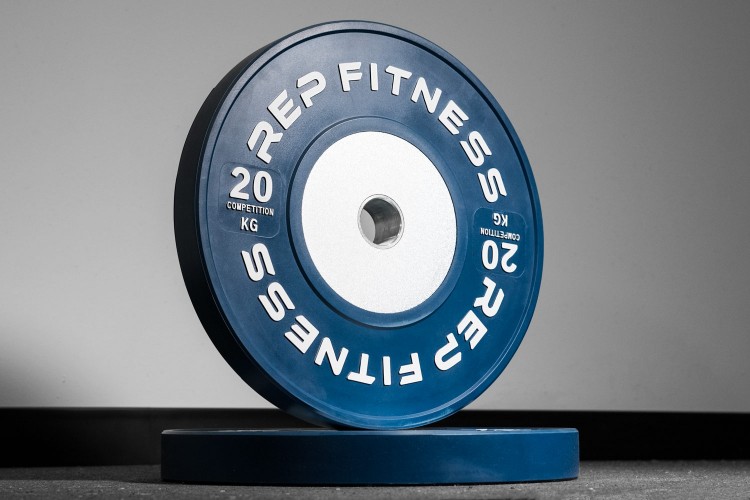
Product Highlights
Our competition bumper plates are the best bumper plates we offer. Ideal for anyone that is serious about Olympic lifting, or needs to be able to fit a lot of weight on the bar.
Pros & Cons
Bottom Line
Comparing the Rogue Competition Bumpers to competition bumpers from REP Fitness, the pricing doesn’t look quite as bad, although Rogue is still more expensive. Both bumper plates are available in a 140-kilogram weight set, which is $1,155 from Rogue, and right at $1,000 from REP Fitness. This comes out to $3.75 and $3.25 per pound, respectively.
RELATED: REP Bumper Plates vs Rogue Bumper Plates
Aside from price, the bumper plates are nearly identical, though the REP 10-kilogram plate is a bit thicker than the Rogue plate. Otherwise, the plate widths are pretty close to each other. The diameters are identical, and REP has a tight weight tolerance as well—within 10 grams.
While both are high-quality plates, Rogue Competition Bumpers are a bit more high-end, due to the IWF certifications. Although the REP plates are built within IWF specifications, they aren’t recognized by the International Weightlifting Federation like Rogue Fitness bumpers are.
Ultimately, if you’re looking for competition-level plates, the REP bumpers are better value. If you absolutely want the IWF certification, Rogue is the way to go. That said, there are plenty of cheaper bumper plates to choose from, too.
You can read more in our REP Fitness Competition Bumper Plates review.
| Rogue Competition Bumpers | REP Competition Bumpers | |
| Material | Rubber | Rubber |
| Weight range | 10-, 15-, 20-, and 25-kg plates | 10-, 15-, 20-, and 25-kg plates |
| Weight tolerance | +/- 15 g of declared weight | +/- 10 g of declared weight |
| Diameter | 450 mm (17.72”) | 450 mm (17.7”) |
| Insert | Chrome-plated steel disc with 50.4-mm collar opening | Zinc-coated steel disc |
| 10 kg plate width | 1.15” | 1.4” |
| 15 kg plate width | 1.65” | 1.6” |
| 20 kg plate width | 2.15” | 2.1” |
| 25 kg plate width | 2.5” | 2.6” |
| Durometer rating | 94 | Not disclosed |
| Warranty | 5 years | 5 years |
Customer Experience
Rogue Fitness Competition Bumper Plates are backed by a 5-year warranty, which is one of the better warranties available. Bumper plates get a lot of wear and tear from constant use and drops, so 5 years is a solid warranty period.
You can make returns within 30 days of receiving your Rogue product, but items must be in their original packaging. Used or damaged items may also be denied a refund or exchange.
In our experience, Rogue Fitness has had consistently great customer service. They also are knowledgeable about the equipment they make and sell. This, in combination with a solid warranty, makes the customer experience rating a 4.5 out of 5.
Ordering the Rogue Competition Bumpers
The Rogue Competition Bumper Plates can be ordered directly from Rogue’s website. Rogue offers financing through PayPal Credit on orders over $99, through Affirm on orders over $250, and through Rigquipment Finance on large orders for commercial gyms, starting at $5,000 of business credit.
You can purchase bumper pairs separately, but Rogue also has a few weight sets to choose as well:
- 90-kg set (pair of 10s, 15s, and 20s)
- 110-kg set (pair of 10s, 20s, and 25s)
- 120-kg set (pair of 15s, 20s, and 25s)
- 140-kg set (pair of 10s, 15s, 20s and 25s)
These sets each include shipping costs already. If you purchase individual pairs, your shipping costs will be calculated at checkout. While these are a good number of set options, I would’ve liked to see a set that had multiple 25-kilogram pairs for stronger athletes. Still, it earns a 4.5 out of 5 for the weight set options.
Customer Reviews
The Rogue Kilogram Competition Bumper Plates score very high from customers, averaging 4.9 out of 5 stars from 37 reviews on the Rogue website at the time of this writing.
There aren’t any vastly negative complaints on the bumper plates, as the lowest ratings are 4 stars. Most positive reviews appreciate the durability and build of the plates, along with Rogue’s strong customer service. One review in particular talks about receiving a faulty bumper plate whose center hub began to shift prematurely. Rogue promptly offered a replacement plate and the customer was thrilled.
Most complaints are minor, but focus on slight inconsistencies in the rubber on the bumper plates. Some customers received some blemishes along the rubber plates’ edges, which was aesthetic and wouldn’t compromise the plate. However, I can understand that if you’re paying for a premium product, you want the quality to be top-notch.
Final Verdict of Our Rogue Competition Bumpers Review
The Rogue Competition Bumpers are some of the best, highest-quality plates on the market. Extremely durable and approved to endure the many, many repetitions of weightlifting competitions, these plates are designed to look sharp and last.
Unfortunately, with that high level of quality also comes a high price tag, one that probably won’t make it worth the cost for your garage gym. Still, if you have the money to spend, or you’re a competitive weightlifter wanting competition-specific bumper plates, these are some of the best plates out there for Olympic weightlifting. Otherwise, I’d opt out for Echo bumpers or a similar bumper plate.
Full Rating
Rogue Competition Bumpers

If you are a competitive weightlifter or simply want a clean, durable bumper, and you have the money, these are a great option.
Product Brand: Rogue Fitness
Product Currency: $
Product Price: 175
Product In-Stock: InStock
4.7
Rogue Competition Bumpers: FAQs
Are Rogue Echo Bumper Plates good?
Made of virgin rubber and with a Durometer rating of 88, the Rogue Echo Bumper Plates are a durable bumper plate with a low, dead bounce and great value. Comparable to some more expensive bumper plates, the Echo plates are thinner and have a rounded edge, which makes the plates easier to grab from the floor.
RELATED: Rogue Echo Bumper Plates Review
How long do competition bumper plates last?
Most high-end competition bumper plates are covered by a multi-year warranty, with some as long as 5 years. However, with a little bit of care and smarts while training (like not dropping your 10-kilogram plates by themselves), they should last much longer than the warranty period.
Are urethane bumpers worth it?
Urethane plates are an excellent option for those looking for durable plates. Made of heavy-duty plastic, urethane bumpers are dense and long-lasting. I’ve had urethane plates for 10 years now, and they show hardly any sign of wear.
What’s the difference between training and competition bumper plates?
Typically, competition bumper plates are made in accordance with IWF specifications—whether or not the brand is recognized by the IWF. With that, there will be tight weight tolerances, and specific diameters for the plates and collar openings. These plates are made to be durable and last through multi-day competitions with thousands of lifts performed on them.
RELATED: What Is a Bumper Plate?
Training plates, on the other hand, don’t always have the same specifications to match, so the level of durability is less. The weight tolerances might be more generous, too. That said, most quality training plates will still be plenty durable for a home gym setting.
However, IWF-certified training plates are fairly identical to competition bumpers, as these plates are approved for use in the training hall at major international competitions. Therefore, these plates are often constructed with the same rigorous specs as competition bumpers.


